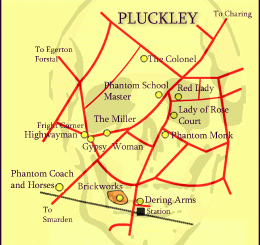The Well Of The Holy Rood, Stenton
The 16th century Well of the Holy Rood at Stenton has a legend attached to its finial which resembles a rosetted cardinal’s hat. The legend states that the tenure of Beil depends upon the well keeping its hat.
William R Cox gave the following detailed description of the well in The Antiquary (Volume 26) (published 1892). ‘Within 200 yards of the old church and village of Stenton, and close by the road leading thence to Dunbar, stands the Rood Well. The path from the old church to the well is paved with stone; this points to an extra amount of traffic to and from the well. It is a small circular building, 3 feet 10 inches internal diameter, and 5 feet 4 inches over, with a door facing north-west, 2 feet I inch wide; present height, 3 feet 7 inches ; height from step, found by probing the ground, 5 feet 5 inches; thickness of the wall, 9 inches, with a conical roof of stone in five courses, finished with a flowered finial of fourteenth-century date on the top. The masonry is a very excellent piece of workmanship, and is in a state of excellent preservation. The entrance -jambs are checked, and prepared to receive a door. Each course of the conical roof is slightly cambered, or rounded, externally, and starts with a small fillet, or drip. The neck moulding of the finial is cut into the shape of a rope, and the base of the finial immediately above is square, and set on the angle, in so far as regards the direction of the door; the upper part is then carried to the octagon by means of a splayed cone, and is gradually formed into an appropriate starting-point for the flowered portion by means of a receding splay fillet ; the finial in the lower and more spreading portion consists of four leaves of the usual conventional treatment in this period of Gothic art. The upper part has been broken away. The stones are all carefully hewn and squared, and show more care in building than the masons of the time usually bestowed on works of far greater importance. The well has long been filled up, and enclosed by a stone wall, owing, as I was told, to a cow in the neighbouring field falling into it, and causing, as one can well understand, extraordinary difficulty in getting her out. The ground slopes from the entrance up towards the road, so that at the back of the well, next to the road, it is higher by about 3 feet 6 inches. When visited in August, 1882, the place was guarded by a luxuriant crop of nettles. It is kept carefully pointed, but is otherwise neglected.’
Observations made by J R Walker in 1883 suggests the finial came from the church in Stenton and is said to date from the 14th century.
By 1966 and a report by Ordnance Survey the path from the church to the well was gone and the well was partially filled in. It was noted as being totally filled in by 1989.




Recent Comments